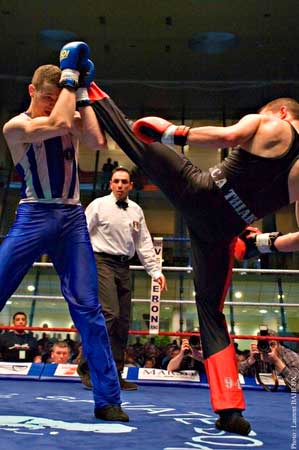 Savate – France: Savate takes its name from the French for old boot(heavy footwear used to be worn during fights) and is actually an amalgam of French street fighting techniques from the beginning of the 19th century. At that time, savate was a type of street fighting common in Paris and the north of France. And in the south, especially in the port of Marseille, sailors had developed a form of fighting involving high kicks, which was known as jeu marseillais (game from Marseille), which was later renamed chausson(slipper, after the type of shoes sailors wore). In contrast, at this time in England (the home of boxing and the Queensberry rules), kicking was seen as unsportsmanlike or as something that only cowards would resort to. (See Muay Thai)
Savate – France: Savate takes its name from the French for old boot(heavy footwear used to be worn during fights) and is actually an amalgam of French street fighting techniques from the beginning of the 19th century. At that time, savate was a type of street fighting common in Paris and the north of France. And in the south, especially in the port of Marseille, sailors had developed a form of fighting involving high kicks, which was known as jeu marseillais (game from Marseille), which was later renamed chausson(slipper, after the type of shoes sailors wore). In contrast, at this time in England (the home of boxing and the Queensberry rules), kicking was seen as unsportsmanlike or as something that only cowards would resort to. (See Muay Thai)
In competitive or competition savate which includes Assault, Pre-Combat, and Combat types, there are only four kinds of kicks allowed along with four kinds of punches allowed:
Kicks
fouetté (literally "whip", roundhouse kick making contact with the toe—hard rubber-toed shoes are worn in practice and bouts), high (figure), medium (median) or low (bas)
chassé (side ("chassé lateral") or front ("chassé frontal") piston-action kick), high (figure), medium (median) or low (bas)
revers (frontal or lateral "reverse" or hooking kick making contact with the sole of the shoe), high (figure), medium (median), or low (bas)
coup de pied bas ("low kick", a front or sweep kick to the shin making contact with the inner edge of the shoe, performed with a characteristic backwards lean) low only
Punches
direct bras avant (jab, lead hand)
direct bras arrière (cross, rear hand)
crochet (hook, bent arm with either hand)
uppercut (either hand)
Savate did not begin as a sport, but as a form of self-defence and fought on the streets of Paris and Marseille. This type of savate was known as savate de rue. In addition to kicks and punches, training in savate de rue (savate defense) includes knee and elbow strikes along with locks, sweeps, throws, headbutts, and takedowns.
|
Below is a video about Savate from The History Channel TV Series Human Weapon
|
|
Please refer to our references as we have used a few different sources for the basic explanation of each martial art discipline. Many of our direct links, images and text will be from the site Wikipedia which is not known for the most accurate information when it comes to doing a thesis or studying for ones P.H.D. but does have a large collection of data that is well organized. Much of the text regarding martial arts styles on Wikipedia seems to generally sum up each discipline as good as many other sources. We do not intend to re-invent the wheel, but we do want to roll you in a good direction in order to get a glimps of each style.
| References: | http://www.usgyms.net | |
| http://en.wikipedia.org | ||

